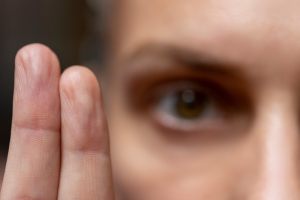Chase walks into the grocery store to buy a few simple items: bananas, milk, and cereal. However, the task proves anything but simple for him. All he can focus on are the other shoppers and the threats that they pose to him—he immediately regrets his confidence in making this quick stop.
It takes Mikey hours to fall asleep at night. Only after he exhausts himself worrying about the sound of the air conditioning turning on and off, the gentle tapping of the tree’s limb on his window, and the inexistent footsteps is he able to drift into a slumber. This symptom of his anxiety disorder is costing him big-time.
Annalise hasn’t been the same since the house fire. She now functions on high alert, shuddering at the sound of sirens, the flickering of candles, and the sight of basic kitchen appliances—ovens, microwaves, stoves. All she sees is destructive potential and she does everything in her power to avoid them.
What is Hypervigilance?
The above characters—Chase, Mikey, and Annalise—all suffer from hypervigilance: a state of heightened alertness and sensitivity that can be caused by fear, anxiety, or certain mental health conditions. As illustrated in the above scenarios, hypervigilance can manifest in somewhat different ways, but is typically characterized by the following signs:
- Marked paranoia, like Mikey worrying about the slightest noises he hears before falling asleep.
- An increased startle reflex and response. For example, these individuals may jump at unexpected or loud sounds.
- An avoidance of potentially threatening situations, such as Annalise’s avoidance of kitchen appliances.
- An elevated heart rate and blood pressure.
- Constant analysis of potential threats, as demonstrated by Chase on his grocery run.
- The overestimation of potential threats. For example, Chase may perceive someone at the store as dangerous when they’re really just innocent shoppers.
The Roots of Hypervigilance
As briefly touched on, hypervigilance is not a disorder itself but can be a direct result or symptom of a possible mental health condition, such as:
- Anxiety: Hypervigilance is often rooted in the wide range of anxiety disorders, such as generalized anxiety disorder and social anxiety disorder. For example, an individual with social anxiety may be nervous and hypervigilant around other people and in public spaces, as demonstrated by Chase at the grocery store.
- PTSD: Another common cause of hypervigilance is post-traumatic stress disorder (PTSD), as illustrated above by Annalise. Annalise survived a house fire and has experienced intense fear, hypervigilance, and other PTSD symptoms ever since.
- Schizophrenia: Individuals who suffer from schizophrenia—a mental illness characterized by a range of cognitive, behavioral, and emotional dysfunctions—may also experience hypervigilance, which can worsen other symptoms of the condition as well, like paranoia and hallucinations.
- Other Triggers: There are certain triggers that may cause or worsen hypervigilance, depending on its underlying cause, such as feeling trapped or abandoned, hearing loud noises, anticipating pain or fear, feeling pain or emotionally distressed, and being reminded of past traumas.
Coping with Hypervigilance
Before one can receive effective treatment for their hypervigilance, a doctor must first determine the underlying cause. Once this is established, the individual will likely be referred to a psychiatrist for therapy and/or be prescribed medication:
- Therapy: There are multiple forms of therapy that may help one manage their hypervigilance, including cognitive behavioral therapy, which can be helpful for those suffering with anxiety, and exposure therapy, which is helpful to those with PTSD.
- Medication: More severe cases of anxiety, PTSD, and other disorders may require the prescription of medication such as antidepressants and anti-anxiety medicines.













